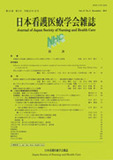Japanese
English
- 有料閲覧
- Abstract 文献概要
- 参考文献 Reference
ABSTRACT
AIM: In order to increase the effectiveness of classes in caregiving and living assistance, we conducted biomechanical analyses of students assisting a seated patient to stand and a standing patient to sit.
METHODS: Participants were sixteen novice female students enrolled in a two-year college program for certified care workers. They were divided into two groups: an athletic group composed of six students with consistent affiliation with athletic programs in both junior high and high school, and a non-athletic group composed of ten students without such experience. We recorded performances of the sit-to-stand and stand-to-sit assistance tasks in three dimensions and measured electromyographic activity.
RESULTS: We found a tendency for students in the athletic group to use the rectus femoris more, flex both knees deeper, and lower the center of mass more than students in the non-athletic group.
CONCLUSIONS: We believe these results indicate that athletic experience can affect stability and performance of assistance tasks. Continuous exercise and athletic experience may help students learn efficient motions and thereby enhance performance of caregiving assistance tasks.
ABSTRACT
AIM: In order to increase the effectiveness of classes in caregiving and living assistance, we conducted biomechanical analyses of students assisting a seated patient to stand and a standing patient to sit.
METHODS: Participants were sixteen novice female students enrolled in a two-year college program for certified care workers. They were divided into two groups: an athletic group composed of six students with consistent affiliation with athletic programs in both junior high and high school, and a non-athletic group composed of ten students without such experience. We recorded performances of the sit-to-stand and stand-to-sit assistance tasks in three dimensions and measured electromyographic activity.
RESULTS: We found a tendency for students in the athletic group to use the rectus femoris more, flex both knees deeper, and lower the center of mass more than students in the non-athletic group.
CONCLUSIONS: We believe these results indicate that athletic experience can affect stability and performance of assistance tasks. Continuous exercise and athletic experience may help students learn efficient motions and thereby enhance performance of caregiving assistance tasks.
Copyright © 2011, Japan Society of Nursing and Health Care All rights reserved.


